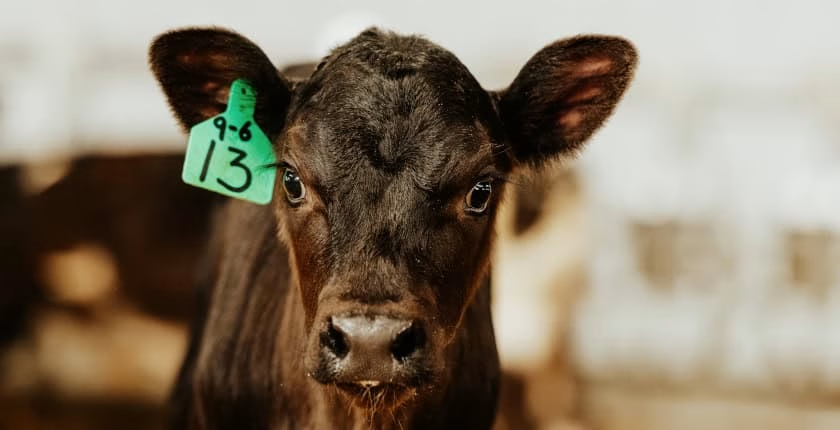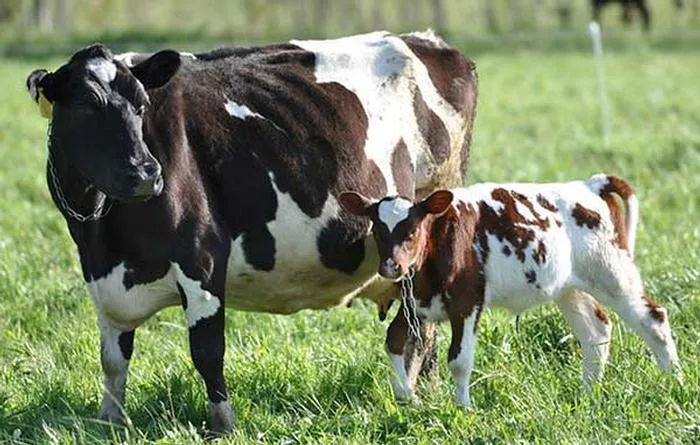Are you curious if your dairy farm can cash in on beef-on-dairy? Discover the basics to check if your setup is ready.
Summary:
A new opportunity is emerging in the dynamic landscape of dairy farming: raising beef-on-dairy cattle. As beef prices rise, dairy farmers increasingly turn to this strategic shift by utilizing beef semen on lower-end dairy cows. This practice maximizes their herd’s value and presents promising financial returns. However, venturing into this enterprise requires careful consideration of feed costs, labor, space, and infrastructure needs. Before diving in, farmers must evaluate their current facilities, market strategies, and operational challenges like additional feed costs and labor requirements. Developing robust market strategies and ensuring optimal living conditions, such as a clean and dry environment with adequately spaced stalls, are crucial. Space, infrastructure, and proper footing require strategic solutions to mitigate risks. Additionally, well-ventilated barns with flexible features like open sides and sliding panels are essential for cattle health. By addressing these factors, dairy farmers can effectively evaluate their farm’s potential and readiness for this exciting frontier.
Key Takeaways:
- Dairy farmers increasingly use beef semen to maximize revenue from low-end dairy cows.
- Beef-on-dairy calves offer a lucrative opportunity, but raising them requires careful planning and additional resources.
- Space, adequate housing, and proper feeding arrangements are crucial for successful beef-on-dairy operations.
- Monitoring ventilation and temperature conditions is essential to prevent respiratory issues in cattle.
- Existing facilities can be adapted for beef-on-dairy ventures but should be optimized for animal health and growth efficiency.
- Farmers should thoroughly understand market dynamics and develop robust marketing strategies before venturing into beef-on-dairy.

As the beef-on-dairy trend continues to rise, dairy farmers are excited about the potential for significantly increased profits. With beef prices soaring, blending dairy operations with beef production is emerging as a lucrative strategy that’s hard to ignore. This shift, not merely about semen selection but a fundamental transformation, promises a brighter financial future. Before diving into the deep end of the beef-on-dairy pool, ask: Is your farm genuinely equipped for the transition? Adapting to this promising opportunity means looking at your current setup hard and evaluating whether it can support this new venture. Numerous factors exist, from ensuring adequate space and feeding facilities to addressing unique housing requirements. It’s about more than just jumping on a trend—it’s about ensuring your infrastructure is ready to support these changes effectively.
| Category | 2023 Average Cost ($) | Expected 2024 Increase (%) | Projection Scenarios |
|---|---|---|---|
| Calf Raising Costs | 50 | 5 | Stable |
| Feed Expenses | 150 | 7 | Moderate |
| Facility Maintenance | 30 | 3 | Low |
| Market Return Per Calf | 200 | 10 | High |
Capitalizing on Rising Beef Prices: A Strategic Shift for Dairy Farmers
The rise in beef prices is a notable market trend, prompting dairy farmers to strategically leverage this by utilizing beef semen on lower-end dairy cows. This adaptation fits well with their existing operations and paves a new avenue for increased income. By producing beef-on-dairy calves, farmers can tap into a lucrative market.
Financial Benefits: By selling these beef-on-dairy calves, dairy farmers can secure a more substantial return than traditional ones. The sale barn values these crossbred calves for their beef potential, offering a financially rewarding opportunity. Some further raise these animals to finishing weight, anticipating even higher profits due to the increased value of mature beef animals. This additional growth phase requires investment in feed and facilities. Still, it promises significant returns, especially amidst current market dynamics where the demand for beef remains robust. This reassures farmers about the potential return on their investment, making the transition to beef-on-dairy operations a more appealing prospect.
Overcoming Operational Challenges: From Feed Costs to Market Strategy
- Additional Feed Costs: Raising beef-on-dairy animals will inherently increase your feed costs, as these animals require substantial nutrition to reach a finishing weight. Are you prepared to allocate a higher feed budget or source cost-effective alternatives?
- Labor Requirements: Managing beef-on-dairy operations demands extra hands on deck. You’ll need to consider the availability and cost of labor for routine tasks and handling potential health issues that may arise with more significant numbers of animals.
- Facility Capabilities: Your existing infrastructure must be evaluated. Can your barns and pens comfortably accommodate additional animals? Can they be adapted at a minimal cost? Adequate space, proper ventilation, and robust flooring are non-negotiable for maintaining animal health and well-being.
- Market Research and Strategy: Before you start, it is essential to conduct thorough research on local market demand and develop a robust marketing strategy to ensure your venture remains profitable.
Establishing Optimal Living Conditions: The Foundation of Calf Health and Profitability
When managing beef-on-dairy calves, a clean and dry environment is a non-negotiable. These conditions are crucial because they significantly reduce the risk of diseases that can impede growth and development, impacting future profitability. Calves, whether from dairy or beef backgrounds, thrive in conditions with top-notch hygiene standards.
Tara Felix, an extension beef specialist at Pennsylvania State University, discusses the housing specifics for these calves. She recommends keeping them in stalls at least 24 inches wide until 9 to 10 weeks old. This early management is pivotal in ensuring uniform growth and easy health monitoring.
Furthermore, Felix advocates for the ‘all-in, all-out’ housing system as a beneficial practice. This method involves housing all calves together and replacing the entire group simultaneously, allowing thorough cleaning and disinfection between batches. This strategy reduces disease transmission and keeps the living quarters at a premium level of cleanliness, fostering a healthier, more stable environment for developing calves.
Space and Infrastructure: Building Blocks of a Successful Beef-on-Dairy Operation
Space and infrastructure needs are crucial considerations when raising beef-on-dairy animals. Farmers may need more facilities to ensure growth performance and health.
One immediate concern is space. Do your facilities have enough pens and feed bunks to accommodate your animals effectively? Lack of space can hinder growth and elevate stress levels among cattle, leading to health problems. Ensuring that each animal has access to comfortable housing can make a noticeable difference in its overall well-being.
If you have limited space, consider strategic solutions. One potential solution is reducing the number of animals housed at the facility. Fewer cattle can equal more space per animal, directly contributing to their health and growth. Alternatively, barn renovations can be considered to optimize existing areas, creating additional pen and bunk space necessary for successful operations.
Moreover, infrastructure is about more than just square footage. Flooring conditions are another vital component. Proper footing, like well-bedded concrete or slatted floors, can mitigate the risks of lameness and injury—issues that are all too common when these aspects are overlooked.
Breathing Easy: Crafting the Perfect Barn Atmosphere for Healthy Revenue
Ventilation and health are critical when raising beef-on-dairy calves. Proper airflow prevents respiratory illnesses, significantly impacting animal welfare and farm profitability. A well-ventilated barn stabilizes temperature and controls humidity—a crucial factor often underestimated. High humidity is a hidden enemy, silently exacerbating respiratory problems more than the cold. Ensuring your barn has at least one open side for natural air exchange is a baseline necessity. Sliding panels or curtains on other sides provide flexibility, allowing adjustments based on weather conditions and humidity levels. Producers can maintain an environment conducive to healthy growth and productivity by prioritizing these aspects in barn design.
The Bottom Line
Adapting existing facilities for beef-on-dairy operations can be a practical and cost-effective strategy, provided they are managed precisely. As clarified, this venture’s entry and exit points hinge heavily on profit projections, making it crucial for farmers to stay agile and informed. Diligent research into local consumer demands and thoughtful marketing strategies are indispensable for thriving in this growing market.
We invite you to join the conversation. How is your farm positioned for beef-on-dairy opportunities? Have you considered the factors we discussed? Please share your insights, leave a comment, or tell us about your experiences in the beef-on-dairy space. By engaging with this community, you’re taking the first step toward evaluating your farm’s potential and readiness for this exciting frontier. Your experiences and insights can be invaluable to other farmers considering this transition.
 Download “The Ultimate Dairy Breeders Guide to Beef on Dairy Integration” Now!
Download “The Ultimate Dairy Breeders Guide to Beef on Dairy Integration” Now!
Are you eager to discover the benefits of integrating beef genetics into your dairy herd? “The Ultimate Dairy Breeders Guide to Beef on Dairy Integration” is your key to enhancing productivity and profitability. This guide is explicitly designed for progressive dairy breeders, from choosing the best beef breeds for dairy integration to advanced genetic selection tips. Get practical management practices to elevate your breeding program. Understand the use of proven beef sires, from selection to offspring performance. Gain actionable insights through expert advice and real-world case studies. Learn about marketing, financial planning, and market assessment to maximize profitability. Dive into the world of beef-on-dairy integration. Leverage the latest genetic tools and technologies to enhance your livestock quality. By the end of this guide, you’ll make informed decisions, boost farm efficiency, and effectively diversify your business. Embark on this journey with us and unlock the full potential of your dairy herd with beef-on-dairy integration. Get Started!













